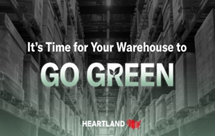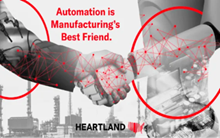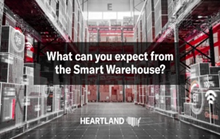
Best Practices When Prioritizing Warehouse Sustainability
Mar 25, 2024
Sustainability is a major concern for warehouses and distribution centers. Searching for ways to reduce the carbon footprint requires a broad view of the many places that our actions are leaving a mark. As a specialist in modern warehouse optimization and workflows, Heartland recommends these best practices when prioritizing warehouse sustainability.
Conduct a sustainability assessment - Partner with a warehouse optimization and sustainability expert to conduct an objective assessment of your operation. Identify the areas where you can make changes to reduce your company’s carbon footprint. Define your warehouse strategy to help establish priorities and objectives. Then, use the assessment to create a warehouse sustainability action plan to achieve the desired results.
Related: Go green with sustainable warehousing.
Automate warehouse workflows - Warehouse automation does more than increase accuracy and productivity. Done correctly, the initiative promotes warehouse sustainability. Sometimes, being environmentally responsible is more than managing materials. It’s how you actually manage the processes that use those materials—the mindset shift.
Related: Deep Dive: Automation’s Role in Modern Manufacturing
Reduce waste - Deploying a productivity solution such as voice-directed picking and RFID warehouse management dramatically reduces the paper trail in your warehouse. Eliminate reams of paper from the waste stream by using a digital method that also delivers real-time visibility and 99.99% accuracy.
Related: How to Reduce Warehouse Waste with Autonomous Mobile Robots
An added benefit of voice-picking is the accuracy it brings to managing inventory and orders. Orders with missing or damaged products represent waste as well. Replacement orders created wasted labor, the cost of the products, and the unnecessary mileage and fuel for the replacement deliveries. Distribution centers for food and perishable products can reduce spoilage that leads to waste. IoT sensors monitor temperatures and send alerts when there’s a change, so you can make an instant adjustment and protect the products.
Increase truck loading and routing efficiency - IoT-enabled warehouse technology, AI and RFID warehouse management, can guide your logistics to more energy-efficient workflows. Pack each truckload fully and safely—protecting both the shipments and the workers who load and unload them. Any load that isn’t full represents wasted fuel, mileage, and labor—which is critical to address for warehouse sustainability issues.
Related: How to Reduce Empty Space in Your Shipping Truck
Rely on the same smart technology to optimize your truck routes, saving fuel and reducing mileage, which impacts the wear and tear of your vehicles. Quickly reroute vehicles with the real-time visibility afforded by warehouse technology driven by RFID and AI.
Optimize storage space - Optimize your warehouse layout for workflow efficiency. With AI guiding the planning, you can determine the best placement for inventory, materials, equipment, and supplies. The right layout could save space, reduce travel within your warehouse, and increase productivity.
Related: Do You Know the Most Common Bottlenecks in the Supply Chain?
When your warehouse layout allows for a higher level of storage space use, you have greater control over inventory and supply levels. Just-in-time (JIT) inventory management is a practical approach when you have a clear view of your order fulfillment activity. JIT lets you consolidate storage space, which leads to reducing your carbon footprint, such as the heating, cooling, and electricity costs for wasted spaces in your warehouse.
Focus on energy conservation across the enterprise - A warehouse is a large consumer of energy. From lighting the large square footage to providing power to run the machinery to heating and cooling the facility, you have significant opportunities to apply best practices when prioritizing warehouse sustainability.
Related: Streamlining Warehouse Energy Consumption? Here are 4 Initiatives
Switch to LED bulbs - LED bulbs consume less energy, provide better quality lighting, and last much longer than incandescent or fluorescent bulbs. You’ll save on energy usage, the purchase of the bulbs, and the time it takes to replace them so frequently.
Install smart lighting - Smart lighting with motion sensors automatically switches on when they detect occupancy and turn off when there is none. With the right placement of those sensors, you can light only those areas within a space that need illumination, rather than lighting up a larger space.
Related: What’s a Smart Warehouse & Do You Have One?
Invest in energy-efficient HVAC - The cost of heating, air conditioning, ventilating and refrigeration systems in a warehouse can be reduced by replacing your energy-guzzling system with a more energy-efficient one. Systems with a higher SEER rating (seasonal energy efficiency ratio) operate more efficiently, so you maintain the temperature you need while using less energy and lowering your utility costs.
Related: Deep Dive: 5 Reasons to Create a Sustainable Plant
Use water-saving systems - Water is necessary in a warehouse for cleaning, cooling, and general maintenance. Replace plumbing fixtures with water-sensing alternatives to reduce the water usage.
Related: What are the benefits of a connected warehouse?
In addition, environmentally responsible businesses employ a water conversion system that treats and recycles water for non-potable uses.
Manage your mobile device deployment - How often do you upgrade your industrial mobile devices ? Are you safely disposing of the outdated technology? Heartland offers a unique mobile device management service that monitors the usage (including configuring, security, and connectivity). AlwaysOn is our commitment to ensuring peace of mind that you have the right devices in the right hands, without worrying about downtime. We’ll also handle all device lifecycle management, from onboarding to decommissioning to environmentally safe disposal.
Related: How to start managing your enterprise mobile devices
Partner with a Sustainability Management Team - Making the eco-friendly changes in your warehouse and then maintaining those initiatives benefits from a professional that understands the ins and outs of warehouse sustainability. Heartland is invested in supporting warehouses, distribution centers, and manufacturing facilities with the technology solutions that increase operational efficiency—which includes sustainability. We can work with you on conducting a warehouse sustainability assessment and then tailor the solutions to meet your goals. Our warehouse optimization experience guides you and your team to the smart, scalable solutions with ROI that can be proven—with mobile devices.
Related: How Sustainability and Logistics Thrive Together
Contact Heartland to take the next step toward achieving the many benefits when you deploy these best practices when prioritizing warehouse sustainability.













